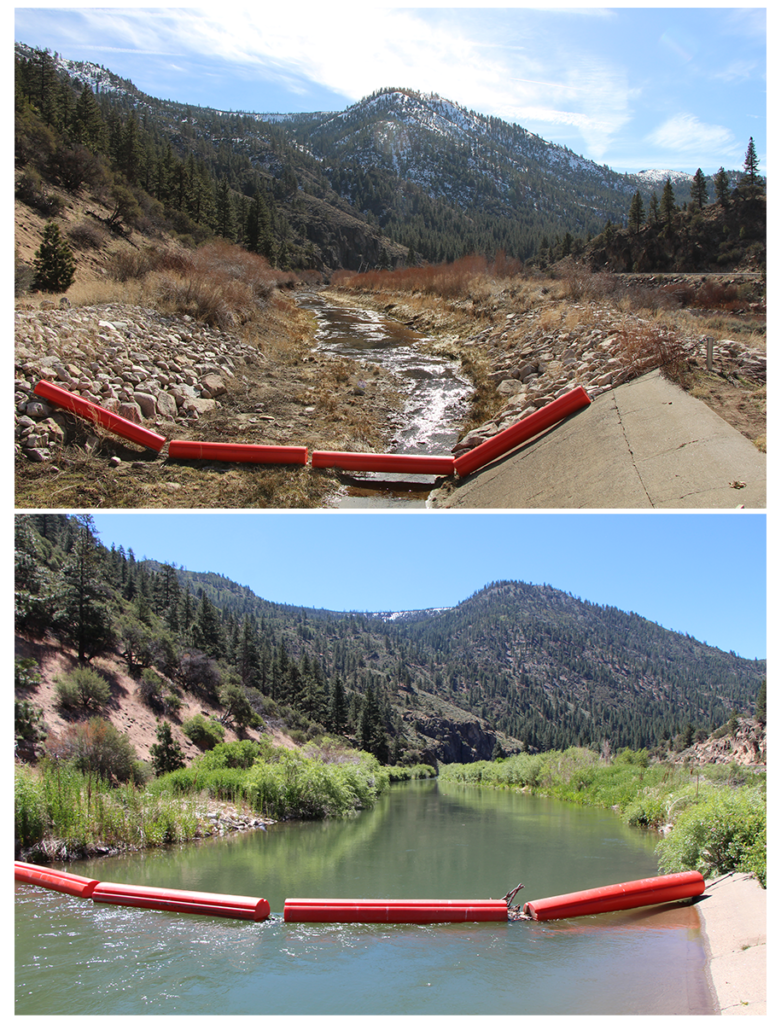Drought

View this Topic Paper as a PDF: Drought
Ver esto en español
TMWA is Always Preparing for Drought Cycles
How are Drought Conditions Declared?
Generally defined, drought is a weather pattern with less than average precipitation over a period of time, ranging from a couple to many years. Over the past 100 years, there have been multiple droughts, with the longest one lasting eight years.
During drought, the level of Lake Tahoe may become low which can impact the amount of water flowing into the Truckee River. When Truckee River flow rates at the California-Nevada state line are below required thresholds outlined in the Truckee River Operating Agreement, drought conditions are declared.
When Lake Tahoe levels go beneath the natural rim of the lake, water is released from other reservoirs to maintain required flow rates. Release of water into the Truckee River is administered by the US Bureau of Reclamation by the Federal Water Master.
How Much of the Truckee river Does TMWA Use?
The Truckee River is TMWA’s primary water source, however we divert only a small percentage of its volume. In a non-drought year, the community typically uses three percent of the Truckee River. During a drought year, TMWA customers might use about eight percent. The remainder flows to other downstream users including the Truckee-Carson Irrigation District, other irrigation users and Pyramid Lake.
How Does TMWA Prepare for a Drought?
Droughts are a common occurrence in Northern Nevada. Optimizing water management strategies and programs to help bolster our community’s resiliency to drought is a priority for TMWA.
Since 2001, TMWA has been building upon a conjunctive use strategy that has increased the resiliency of our water system through the coordinated management of surface and ground water.
During periods of high demand in the summertime, groundwater can be used to supplement Truckee River water. During cooler months when demand decreases, wells are rested so aquifer levels can recharge. This is accomplished by natural processes and through TMWA’s Aquifer Storage and Recovery program, which uses treated drinking water to recharge area aquifers.
From a demand perspective, TMWA’s many ongoing conservation programs are designed to reduce waste or increase efficiency of how water is used. In fact, every summer customers are asked to use Assigned-Day Watering (see sidebar link), which has been successful in managing peak water use during summer months for over 30 years.
These preparations also help TMWA to store as much water as possible upstream as drought reserves, for use when warranted.
How Does TMWA React During Drought?
TMWA’s Water Resource Plan outlines our water system’s resilience and identifies all the mitigation responses that can be enacted during drought. For example, TMWA may begin using more groundwater wells earlier in the summer than normal. Drought reserves can be used to help meet customer demand, as designed to do and as a result of TMWA’s conjunctive use strategy and water management planning.
Enhanced conservation is deployed during drought as well. These initiatives are more active during summertime months, when customer demand is three to four times higher than in winter months due to irrigation. Actions may include as expanding daily outdoor ‘no watering’ time restrictions within the Assigned-Day Watering program, which is normally noon – 6p but expands to 11a to 7p with enhanced conservation. TMWA can also increase staffing levels for TMWA’s Water Watcher program, which brings awareness and education regarding water waste into neighborhoods.
Many other additional tactics can also be applied as well if drought persists, which can be reviewed in Chapter 4 of TMWA’s 2020-2040 Water Resource Plan.
OTHER COMMON QUESTIONS RELATED TO DROUGHT
Why Isn't TMWA Considering Other Conservation Methods, Such as Paying for Grass Removal?
All water systems across the country are different. While some water utilities in other communities can resell conserved water (e.g., water saved from turf removal), water in the Truckee Meadows cannot be resold.
Related, conserved water cannot be used to support new growth per the Truckee River Operating Agreement (TROA), which is administered by the Federal Water Master and defines how the water in the Truckee River is managed.
Nevertheless, TMWA fully recognizes the importance of water efficient landscaping that is well suited to our arid climate. To encourage smart water use, TMWA’s Water Efficient Landscape Guide is a comprehensive resource for planning, planting and maintaining a water-efficient yard. Also, our conservation department hosts seasonal workshops to ensure that irrigation systems are well maintained and leak-free.
Is the Water Homeowners Conserve Every Day Used for Growth to Build More Houses or Businesses?
No, as stated above TMWA cannot resell conserved water, this includes new development. During drought, water conserved by TMWA customers can be held upstream as additional drought reserves and used if the drought continues. Also, water rights that are dedicated to serve existing homes and businesses cannot be transferred for new development.
Resources
Truckee River Operating Agreement (TROA)
Conjunctive Use Video (3 minutes)
Water Efficient Landscape Guide